Introduction to Women’s Weight Loss
The Unique Challenges Women Face in Weight Loss
Hormonal Differences and Their Impact
Women’s hormones, especially estrogen and progesterone, play a significant role in regulating body weight. These hormones influence fat storage, metabolism, and hunger levels, making weight loss more challenging during different life stages such as menstruation, pregnancy, and menopause.
The Importance of Personalized Weight Loss Approaches
Since women have unique hormonal cycles and body compositions, a one-size-fits-all approach to weight loss won’t work. Tailoring a plan that considers metabolism, body composition, and lifestyle factors is essential for long-term success.
Understanding Women’s Body Composition
Fat vs. Muscle Mass in Women
The Role of Muscle in Weight Loss
Muscle mass plays a vital role in weight loss because muscle is metabolically active, meaning it burns more calories than fat. By increasing muscle mass through strength training, women can raise their resting metabolic rate and burn more calories, even when not exercising.
Essential vs. Storage Fat
Women’s bodies naturally have more fat than men’s, partly due to reproductive needs. Essential fat is necessary for health and hormone regulation, while storage fat is excess fat stored for energy. Understanding the difference helps women manage their weight effectively.
For more insights into women’s body composition, check out our article on Understanding Women’s Body Composition.
The Importance of Body Composition Over Weight
Why Muscle Mass Matters More Than the Number on the Scale
Focusing solely on weight can be misleading. Women with more muscle may weigh more but have a leaner, more toned appearance. Instead of obsessing over the scale, focusing on building muscle and reducing body fat provides better health and aesthetic results.
Measuring Body Composition
There are various ways to measure body composition, such as skinfold calipers, bioelectrical impedance, and DEXA scans. These methods provide more accurate insights into fat and muscle percentages than the number on a scale.
Metabolism and Women: What You Need to Know
How Metabolism Affects Weight Loss
Understanding Basal Metabolic Rate (BMR)
Your basal metabolic rate (BMR) refers to the number of calories your body burns at rest to maintain essential functions like breathing and digestion. Women’s BMRs tend to slow with age and hormonal changes, which can make weight loss more difficult over time.
The Role of Muscle in Boosting Metabolism
Building and maintaining muscle is one of the best ways to boost metabolism. Since muscle burns more calories than fat, even at rest, increasing muscle mass can help women burn more calories throughout the day and support fat loss.
Factors That Slow Women’s Metabolism
Age, Hormones, and Metabolic Decline
As women age, hormonal shifts, particularly after menopause, can slow metabolism and increase fat storage. Understanding these changes is crucial for developing effective weight loss strategies that account for reduced metabolic rates.
Under-Eating and Metabolic Slowdown
Extreme calorie restriction can cause metabolic slowdown, as the body conserves energy in response to fewer calories. This often leads to plateaus in weight loss, making it important to eat enough calories to fuel the body while creating a modest deficit.
Learn more about metabolism in women by visiting our article on Metabolism and Women: What You Need to Know.
Calories In vs. Calories Out: What Women Need to Know
The Science of Weight Loss: Caloric Deficit
What is a Caloric Deficit?
To lose weight, women need to burn more calories than they consume, creating a caloric deficit. This means balancing the number of calories eaten with those burned through daily activities and exercise. The key is finding the right balance to avoid overeating or under-eating.
How to Calculate Your Daily Calorie Needs
Understanding your Total Daily Energy Expenditure (TDEE) is essential for calculating how many calories you need to maintain, lose, or gain weight. TDEE takes into account your BMR, activity level, and exercise habits to give an accurate calorie range for weight loss.
The Importance of Quality Calories
Nutrient-Dense Foods vs. Empty Calories
All calories are not created equal. Nutrient-dense foods, such as vegetables, lean proteins, and whole grains, provide more vitamins, minerals, and fiber than processed foods and sugary snacks. Choosing quality calories helps women stay full, energized, and on track with their weight loss goals.
Balancing Macronutrients: Protein, Carbs, and Fats
A balanced diet that includes adequate protein, healthy fats, and carbohydrates is crucial for weight loss. Protein is particularly important for preserving muscle mass during a caloric deficit, while healthy fats and carbs fuel workouts and daily activities.
For a deeper dive into calorie balance, read our article on Calories In vs. Calories Out: What Women Need to Know.
Common Pitfalls in Women’s Weight Loss
Why Extreme Diets Don’t Work
The Dangers of Restrictive Diets
Extreme diets that severely restrict calories or eliminate entire food groups can lead to muscle loss, nutritional deficiencies, and eventual weight gain. These diets are unsustainable, causing women to regain weight once they resume normal eating habits.
Sustainable Weight Loss Strategies
Successful weight loss focuses on gradual progress through a balanced diet and regular exercise. Women who adopt slow and steady weight loss habits, rather than extreme measures, are more likely to maintain their results long-term and avoid the yo-yo effect.
Emotional Eating and Its Impact on Weight Loss
How Stress and Emotional Triggers Affect Eating Habits
Emotional eating, triggered by stress, anxiety, or boredom, can sabotage weight loss efforts. Learning to recognize these emotional triggers and finding healthier ways to cope—such as meditation or physical activity—can prevent overeating.
Building a Healthy Relationship with Food
Developing a healthy relationship with food is key to successful weight loss. Practicing mindful eating, where you pay attention to hunger cues and savor each bite, can help women enjoy their meals and reduce emotional overeating.
Conclusion
Building a Sustainable Weight Loss Plan
Understanding body composition, metabolism, and the principles of caloric deficit are the foundations of effective weight loss for women. By focusing on building muscle, eating nutrient-dense foods, and maintaining a balanced approach, women can achieve sustainable, long-term results.
Call to Action: Explore ShapioX Resources
At ShapioX, we offer a range of resources to help women reach their weight loss and fitness goals, including calorie calculators, workout plans, and nutrition guides. For more information on women’s weight loss strategies, visit this resource.
Explore our website to access our comprehensive range of programs, tools, and products designed to support your weight loss journey. You can also find additional expert advice on healthy weight loss by visiting this trusted source.


